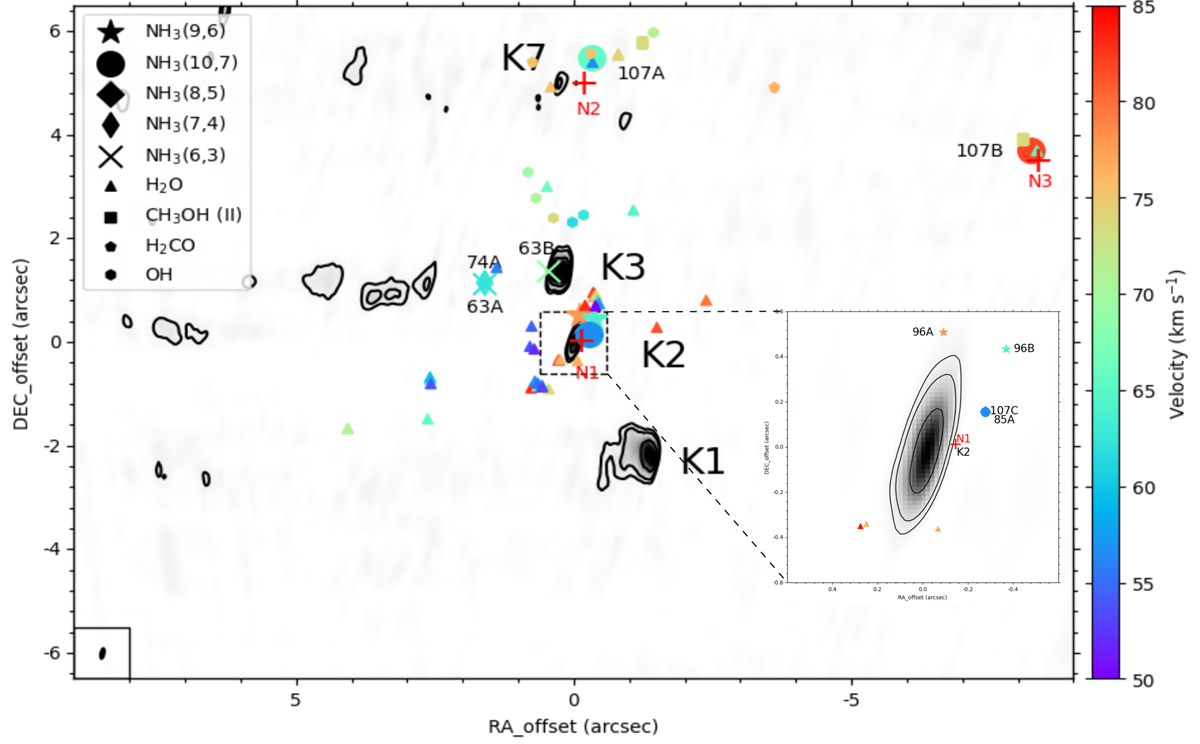Fig. 2.

Download original image
JVLA 1.6 cm continuum map of Sgr B2(N), shown by the gray shaded areas and black contours with levels of 5, 10, 30, and 50 × 0.2 mJy beam−1. The reference position is ![]() , and
, and ![]() , the peak position of the continuum source K2. The crosses, thin diamonds, diamonds, stars, and circles show the positions of NH3 (6,3), (7,4), (8,5), (9,6), and (10,7) emissions. H2O (McGrath et al. 2004), class II CH3OH (Caswell 1996; Lu et al. 2019), H2CO (Mehringer et al. 1994; Hoffman et al. 2007; Lu et al. 2019), and OH (Gaume & Claussen 1990) masers are presented as triangles, squares, pentagons, and hexagons, respectively. The color bar indicates the velocity range (VLSR) of maser spots. Red crosses mark the positions of the hot cores Sgr B2(N1), N2, and N3, taken from the 3 mm imaging line survey “Exploring Molecular Complexity with ALMA” (EMoCA, Bonfand et al. 2017). The systemic velocities of the hot cores N1, N2, and N3 are VLSR = 64 km s−1, VLSR = 74 km s−1 and VLSR = 74 km s−1, respectively (Bonfand et al. 2017).
, the peak position of the continuum source K2. The crosses, thin diamonds, diamonds, stars, and circles show the positions of NH3 (6,3), (7,4), (8,5), (9,6), and (10,7) emissions. H2O (McGrath et al. 2004), class II CH3OH (Caswell 1996; Lu et al. 2019), H2CO (Mehringer et al. 1994; Hoffman et al. 2007; Lu et al. 2019), and OH (Gaume & Claussen 1990) masers are presented as triangles, squares, pentagons, and hexagons, respectively. The color bar indicates the velocity range (VLSR) of maser spots. Red crosses mark the positions of the hot cores Sgr B2(N1), N2, and N3, taken from the 3 mm imaging line survey “Exploring Molecular Complexity with ALMA” (EMoCA, Bonfand et al. 2017). The systemic velocities of the hot cores N1, N2, and N3 are VLSR = 64 km s−1, VLSR = 74 km s−1 and VLSR = 74 km s−1, respectively (Bonfand et al. 2017).
Current usage metrics show cumulative count of Article Views (full-text article views including HTML views, PDF and ePub downloads, according to the available data) and Abstracts Views on Vision4Press platform.
Data correspond to usage on the plateform after 2015. The current usage metrics is available 48-96 hours after online publication and is updated daily on week days.
Initial download of the metrics may take a while.


